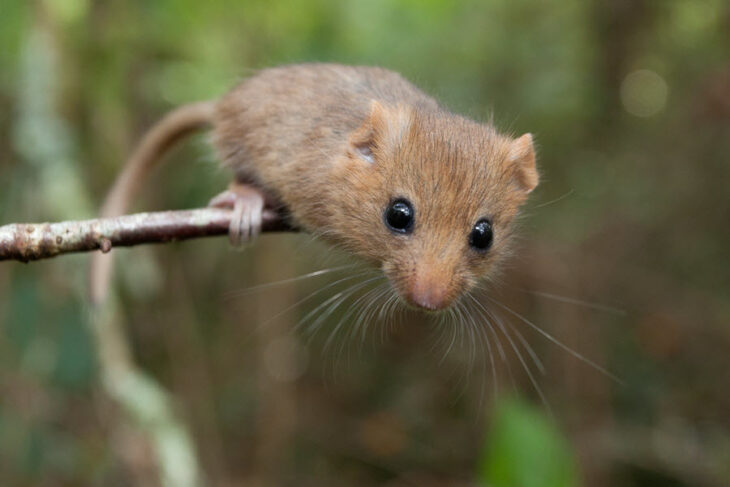A new report published on Wednesday 20 November 2019 by People’s Trust for Endangered Species (PTES) has revealed that Britain’s population of hazel dormice (Muscardinus avellanarius) has declined by 51% since the millennium, decreasing on average by 3.8% per year.
The State of Britain’s Dormice 2019
The State of Britain’s Dormice 2019 report underlines the importance of providing the right habitat for dormice, and maintaining such habitats via correct woodland management practices, is the key to bringing this endangered species back from the brink.
In Britain, dormice – known for their endearing appearance with soft caramel fur, furry tail and big black eyes – are threatened and are considered to be vulnerable to extinction. In fact, hazel dormice are already extinct from 17 counties in England. The areas where they are still known to exist are almost all entirely south of a line between Shropshire and Suffolk.
Ian White, Dormouse & Training Officer at PTES, explains:
“The decline in dormouse numbers is due to the loss and fragmentation of their natural woodland and hedgerow habitats, as well as climate change. In particular, it’s the loss of habitat quality that’s of real concern. Sympathetic woodland management is essential for the recovery of dormice. Whether woodlands are managed for timber or public access, shrubby areas should be created beneath the tree canopy. These provide dormice, and many other species with areas to nest and feed in while also being able to access the mature trees. It is this variety of woodland habitats required to help dormice survive.”
Hazel dormice are arboreal mammals who prefer structurally diverse habitats – they use tree holes to nest in, dense woodland understory to raise their young and feed in, and hedgerows and bramble banks to disperse through. Critically, the way in which woodlands are managed has changed – with traditional management practices such as coppicing, glade creation and small-scale tree felling (which once created mosaic habits) becoming less common, and as a result many of the woodlands we see today simply aren’t suitable for dormice. These factors, combined with unseasonable or extreme weather (which can affect survival over the winter and impact on their ability to raise young), can be detrimental to dormice survival.

A little good news
But, despite this, there are some areas where dormice numbers are increasing. At 96 of 336 sites (29%) analysed for this report, populations were ‘stable’ or ‘increasing’. Also, at 28 of these sites (8% of the total) the average annual increase was 5% or more per year. But, elsewhere, there is still lots of work to do.
PTES is working hard to ensure that dormice can thrive once again in our countryside and manages the National Dormouse Monitoring Programme (NDMP) – the longest-running small terrestrial mammal monitoring programme in the world. Since it began in 1990 hundreds of volunteers across England and Wales have collected over 120,000 records, providing a significant dataset which indicates how dormouse populations are faring. It’s these data that have been used in the State of Britain’s Dormice 2019 report.
In addition, over the last 26 years, PTES has managed 30 reintroductions at 24 sites, releasing almost 1000 captive-bred dormice to create new populations or improve genetic diversity at existing ones. These reintroductions play an important role in the long-term conservation of the species, returning dormice to 12 counties in England where they have been lost.
Training and research
PTES also provides training and guidance for woodland managers, encouraging them to adopt appropriate land management practices. PTES’ Managing Small Woodlands for Dormice can be downloaded here.
PTES is working to improve our understanding of dormouse ecology and to improve the problem of habitat fragmentation. The conservation charity is funding research into hibernation when dormice can be very vulnerable; PTES has recently launched the Great British Hedgerow Survey, whereby farmers and landowners are being asked to assess the condition of their hedgerows and PTES is working with the ecological consultancy Animex to create dormouse bridges to improve accessibility between habitats
Ian concludes:
“Although the State of Britain’s 2019 report shows a severe decline has taken place over the last 18 years, the good news is that in some areas dormice are doing well. We can help bring this species back if we alter the way we manage our landscape. By providing enough of the right habitat, which is well-connected and managed correctly, dormice, as well as a huge amount of other wildlife, can thrive once again across the country.”
To read the full report, and to find out more about PTES’ ongoing dormouse conservation work please visit the PTES website.
